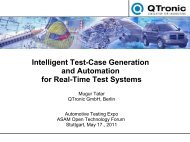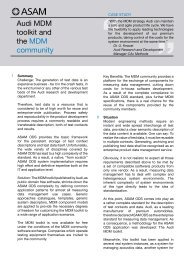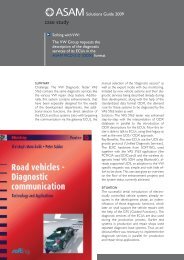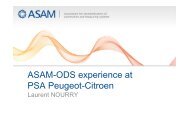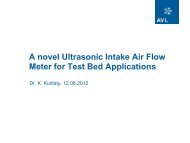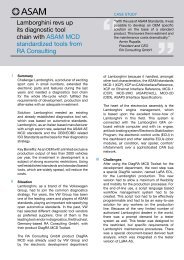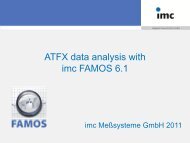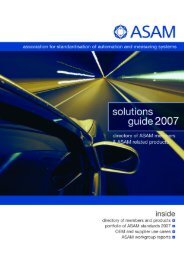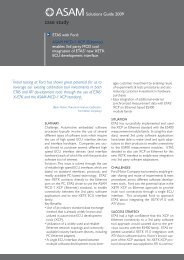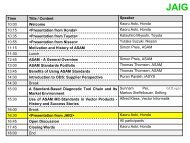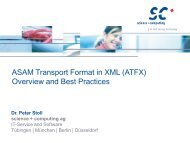You also want an ePaper? Increase the reach of your titles
YUMPU automatically turns print PDFs into web optimized ePapers that Google loves.
PUMA open testbed<br />
automation system of AVL<br />
supports <strong>ASAM</strong> GDI to<br />
enable GDI device integration<br />
i<br />
ii<br />
Summary<br />
Enable easy integration of various devices to<br />
the testbed automation system to represent<br />
different application is a main task of testbed<br />
automation.<br />
AVL has now integrated the <strong>ASAM</strong> GDI<br />
framework into the new release of the testbed<br />
automation software PUMAOpen.<br />
At the same time <strong>ASAM</strong> GDI drivers for AVL<br />
emission measurement devices (emission<br />
bench AMAxxxx series , GEM110, CEB-II) and<br />
sampling systems (CVS) are available. <strong>ASAM</strong><br />
GDI device drivers for PTS systems are under<br />
development and will be released until<br />
Q3/2007.<br />
<strong>ASAM</strong> GDI, with defined Interfaces to the<br />
application and the different companion<br />
specifications for device types, enables fast<br />
integration of devices.<br />
Situation<br />
Test and automation systems mostly require<br />
proprietary drivers for each connected device<br />
or subsystem. Also each device family or<br />
sometimes different firmware versions require<br />
device driver modifications. Such an<br />
inhomogeneous environment involves a lot of<br />
time and effort of the system integrator and<br />
OEM.<br />
Existing companion standards with a defined<br />
standard interface and functionality reduces<br />
this effort. Each device which is compliant to<br />
this standard should be integrated easily and<br />
switching from one device to another is easily<br />
done by loading different configuration file<br />
(application DCD).<br />
iii<br />
iv<br />
CASE STUDY<br />
“AVL has created the companion standard for<br />
emission benches and emission sampling<br />
systems. This is an important step for<br />
powertrain testing. This brings integration to a<br />
new level of flexibilty and interchangeability<br />
that will benefit the GM Powertrain new<br />
laboratory in Pontiac, MI USA.”<br />
Marlin Turbett<br />
GM Powertrain Test Technology<br />
Solutions Guide 2007<br />
Challenges<br />
Target of the project was to integrate <strong>ASAM</strong><br />
GDI framework into the automation systems<br />
environment in a way, that:<br />
• GDI devices integrated in the system<br />
have the same behavior (PUMA device)<br />
• Implementation is generic to face the<br />
advantage of adding additional GDI<br />
devices to the system without<br />
touching software<br />
Solution<br />
AVL developed an integrated <strong>ASAM</strong> GDI<br />
coordinator based on <strong>ASAM</strong> GDI specification<br />
4.3.1 which is integrated as a “PUMA device”.<br />
Therefore, for the user a GDI-device has the<br />
same behavior than other PUMA devices<br />
added to the automation system.<br />
According to the <strong>ASAM</strong> GDI specification, the<br />
GDI framework is divided in three parts:<br />
Coordinator, Device driver and Platform<br />
adapter.<br />
The coordinator implementation as a “PUMA<br />
device”, which supports realtime functionality,<br />
recommends that the coordinator is divided in<br />
two parts. The “non-realtime” part and a<br />
“realtime” part running in the realtime system<br />
of PUMAOpen.<br />
The device drivers are developed as dll or rsl<br />
components to be used in realtime or none<br />
realtime environment. The integrated<br />
coordinator supports both solutions.<br />
As part of the GDI environment of PUMA the<br />
device configuration editor is available to<br />
generate new configuration tree out of the dcd<br />
and also to generate the specific device<br />
configuration. Basically this editor generates a<br />
33



